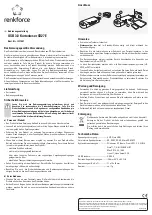
Chapter 11 Profile Screens
Management Switch Card User’s Guide
357
11.8 Configured Versus Actual SHDSL Rates
You configure the maximum and minimum rates of individual SHDSL ports using the set profile
command. However, due to noise and other factors on the line, the actual rate may not reach the
maximum that you specify.
Even though you can specify arbitrary numbers in the set profile command, the actual rate is
always a multiple of 64 Kbps. If you enter a rate that is not a multiple of 64 Kbps, the actual value
will be the next lower multiple of 64Kbps. For instance, if you specify 2100 Kbps for a port, the
actual value will be 2048 Kbps, and if you specify 2120 Kbps, the actual value will be 2112 Kbps.
Note that when you configure a SHDSL profile, the upstream and downstream speeds are the
same. The minimum rate must be less than or equal to the maximum rate.
11.9 N-wire Mode
The n-wire mode allows you to physically bundle two SHDSL ports into a single 4-wire connection.
The 4-wire mode is described in ITU-T G.991.2. You can use it to connect to SHDSL modems or
routers that also support 4-wire mode. N-wire mode also allows you to physically bundle four
SHDSL ports into a single 8-wire connection. The 8-wire group is called mpair4.
ISDD Sensitivity
[-128~127]
The Indication of Severely Degraded Data (ISDD) sensitivity is a Broadcom proprietary
parameter that provides an extension to the standard to allow you to adjust the Impulse
Noise Sensor sensitivity.
•
The ISDD range is -12.8 dB to 12.7 dB in 0.1 dB steps (use -128~127).
•
Use the nominal 0 dB value to use the same threshold used to declare a degraded
symbol, that is a symbol marked as erased.
•
Use a positive value to indicate by how many to dB to increase the nominal threshold.
This makes the sensor less sensitive and means fewer symbols will be considered
degraded.
•
Use a negative value to indicate by how many to dB to decrease the nominal
threshold. This makes the sensor more sensitive and means more symbols will be
considered degraded.
Apply
Click
Apply
to save the changes in this screen to the system’s volatile memory. The
system loses these changes if it is turned off or loses power, so use the
Config Save
link
on the navigation panel and then the
Save
button to save your changes to the non-
volatile memory when you are done configuring.
The new or modified entry then displays in the summary table below.
New
While you are modifying a profile, you can click
New
to start configuring a fresh profile
without saving your changes.
Cancel Click
Cancel
to start configuring the screen again.
Index
This is the number of a VDSL2 INM profile.
Name
This field displays the descriptive name of a profile.
Modify
Select a profile’s
Select
radio button and click
Modify
to edit the profile.
Delete
Select a profile’s
Select
radio button and click
Delete
to remove the profile.
Table 167
Profile > VDSL2 > InmProfile
LABEL
DESCRIPTION
Summary of Contents for MSC1000G Series
Page 38: ...Table of Contents Management Switch Card User s Guide 38...
Page 39: ...39 PART I Introduction...
Page 40: ...40...
Page 54: ...Chapter 1 Getting to Know Your MSC Management Switch Card User s Guide 54...
Page 61: ...61 PART II Web Configurator...
Page 62: ...62...
Page 80: ...Chapter 3 The Web Configurator Management Switch Card User s Guide 80...
Page 162: ...Chapter 5 Alarm Screens Management Switch Card User s Guide 162...
Page 178: ...Chapter 6 Diagnostic Screens Management Switch Card User s Guide 178...
Page 184: ...Chapter 7 Maintenance Screens Management Switch Card User s Guide 184...
Page 204: ...Chapter 8 Multicast Screens Management Switch Card User s Guide 204...
Page 226: ...Chapter 9 Subscriber Port Setup Screens Management Switch Card User s Guide 226...
Page 227: ...Chapter 9 Subscriber Port Setup Screens Management Switch Card User s Guide 227...
Page 330: ...Chapter 10 IMA Screens Management Switch Card User s Guide 330...
Page 412: ...Chapter 11 Profile Screens Management Switch Card User s Guide 412...
Page 512: ...Chapter 12 Statistics Screens Management Switch Card User s Guide 512...
Page 560: ...Chapter 13 Switch Screens Management Switch Card User s Guide 560...
Page 598: ...Chapter 15 VLAN Screens Management Switch Card User s Guide 598...
Page 636: ...Chapter 16 VoIP Management Switch Card User s Guide 636...
Page 638: ...Chapter 17 Config Save Management Switch Card User s Guide 638...
Page 639: ...639 PART III Commands...
Page 640: ...640...
Page 646: ...Chapter 18 Commands Management Switch Card User s Guide 646...
Page 682: ...Chapter 19 acl Commands Management Switch Card User s Guide 682...
Page 690: ...Chapter 20 alarm Commands Management Switch Card User s Guide 690...
Page 696: ...Chapter 22 config Commands Management Switch Card User s Guide 696...
Page 754: ...Chapter 28 multicast Commands Management Switch Card User s Guide 754...
Page 840: ...Chapter 29 port Commands Management Switch Card User s Guide 840...
Page 924: ...Chapter 30 profile Commands Management Switch Card User s Guide 924...
Page 926: ...Chapter 31 redundant Commands Management Switch Card User s Guide 926...
Page 1062: ...Chapter 35 vlan Commands Management Switch Card User s Guide 1062...
Page 1103: ...1103 PART IV Troubleshooting Specifications Appendices and Index...
Page 1104: ...1104...
Page 1134: ...Chapter 39 Product Specifications Management Switch Card User s Guide 1134...
Page 1146: ...Appendix B Legal Information Management Switch Card User s Guide 1146...
















































